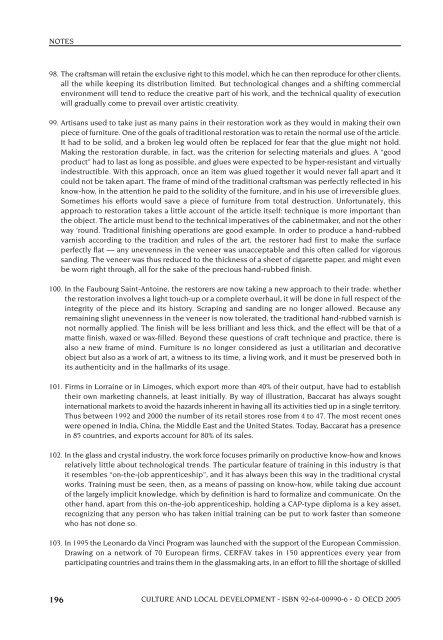OECD Culture and Local Development.pdf - PACA
OECD Culture and Local Development.pdf - PACA
OECD Culture and Local Development.pdf - PACA
You also want an ePaper? Increase the reach of your titles
YUMPU automatically turns print PDFs into web optimized ePapers that Google loves.
NOTES<br />
98. The craftsman will retain the exclusive right to this model, which he can then reproduce for other clients,<br />
all the while keeping its distribution limited. But technological changes <strong>and</strong> a shifting commercial<br />
environment will tend to reduce the creative part of his work, <strong>and</strong> the technical quality of execution<br />
will gradually come to prevail over artistic creativity.<br />
99. Artisans used to take just as many pains in their restoration work as they would in making their own<br />
piece of furniture. One of the goals of traditional restoration was to retain the normal use of the article.<br />
It had to be solid, <strong>and</strong> a broken leg would often be replaced for fear that the glue might not hold.<br />
Making the restoration durable, in fact, was the criterion for selecting materials <strong>and</strong> glues. A “good<br />
product” had to last as long as possible, <strong>and</strong> glues were expected to be hyper-resistant <strong>and</strong> virtually<br />
indestructible. With this approach, once an item was glued together it would never fall apart <strong>and</strong> it<br />
could not be taken apart. The frame of mind of the traditional craftsman was perfectly reflected in his<br />
know-how, in the attention he paid to the solidity of the furniture, <strong>and</strong> in his use of irreversible glues.<br />
Sometimes his efforts would save a piece of furniture from total destruction. Unfortunately, this<br />
approach to restoration takes a little account of the article itself: technique is more important than<br />
the object. The article must bend to the technical imperatives of the cabinetmaker, <strong>and</strong> not the other<br />
way ‘round. Traditional finishing operations are good example. In order to produce a h<strong>and</strong>-rubbed<br />
varnish according to the tradition <strong>and</strong> rules of the art, the restorer had first to make the surface<br />
perfectly flat — any unevenness in the veneer was unacceptable <strong>and</strong> this often called for vigorous<br />
s<strong>and</strong>ing. The veneer was thus reduced to the thickness of a sheet of cigarette paper, <strong>and</strong> might even<br />
be worn right through, all for the sake of the precious h<strong>and</strong>-rubbed finish.<br />
100. In the Faubourg Saint-Antoine, the restorers are now taking a new approach to their trade: whether<br />
the restoration involves a light touch-up or a complete overhaul, it will be done in full respect of the<br />
integrity of the piece <strong>and</strong> its history. Scraping <strong>and</strong> s<strong>and</strong>ing are no longer allowed. Because any<br />
remaining slight unevenness in the veneer is now tolerated, the traditional h<strong>and</strong>-rubbed varnish is<br />
not normally applied. The finish will be less brilliant <strong>and</strong> less thick, <strong>and</strong> the effect will be that of a<br />
matte finish, waxed or wax-filled. Beyond these questions of craft technique <strong>and</strong> practice, there is<br />
also a new frame of mind. Furniture is no longer considered as just a utilitarian <strong>and</strong> decorative<br />
object but also as a work of art, a witness to its time, a living work, <strong>and</strong> it must be preserved both in<br />
its authenticity <strong>and</strong> in the hallmarks of its usage.<br />
101. Firms in Lorraine or in Limoges, which export more than 40% of their output, have had to establish<br />
their own marketing channels, at least initially. By way of illustration, Baccarat has always sought<br />
international markets to avoid the hazards inherent in having all its activities tied up in a single territory.<br />
Thus between 1992 <strong>and</strong> 2000 the number of its retail stores rose from 4 to 47. The most recent ones<br />
were opened in India, China, the Middle East <strong>and</strong> the United States. Today, Baccarat has a presence<br />
in 85 countries, <strong>and</strong> exports account for 80% of its sales.<br />
102. In the glass <strong>and</strong> crystal industry, the work force focuses primarily on productive know-how <strong>and</strong> knows<br />
relatively little about technological trends. The particular feature of training in this industry is that<br />
it resembles “on-the-job apprenticeship”, <strong>and</strong> it has always been this way in the traditional crystal<br />
works. Training must be seen, then, as a means of passing on know-how, while taking due account<br />
of the largely implicit knowledge, which by definition is hard to formalize <strong>and</strong> communicate. On the<br />
other h<strong>and</strong>, apart from this on-the-job apprenticeship, holding a CAP-type diploma is a key asset,<br />
recognizing that any person who has taken initial training can be put to work faster than someone<br />
who has not done so.<br />
103. In 1995 the Leonardo da Vinci Program was launched with the support of the European Commission.<br />
Drawing on a network of 70 European firms, CERFAV takes in 150 apprentices every year from<br />
participating countries <strong>and</strong> trains them in the glassmaking arts, in an effort to fill the shortage of skilled<br />
196 CULTURE AND LOCAL DEVELOPMENT - ISBN 92-64-00990-6 - © <strong>OECD</strong> 2005














